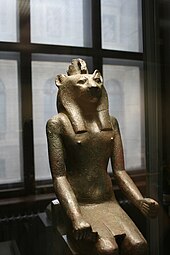Mahes
| Mahes in hieroglyphics | ||||||
|---|---|---|---|---|---|---|
| mostly |
|
|||||
| transcription | M3ḥs | |||||
Mahes , also Maahes , Miysis or Miôs is a lion deity in Egyptian mythology .
Surname
Miysis or Miôs is the Greek name for the Egyptian lion god Mahes, which means "wild-looking lion". The word M3Ḥs itself is used as a general term for lion, but also as the name of lion gods.
presentation

Mahes is represented either as a lion or as a person with a lion's head. In pictures in Philae or Dendera he appears as a protective deity, which shows him with a knife in his paws and a lotus plant standing behind him . As a revered form of the sun god, he wears a sun disk or the Atef crown on his head. Often there are also images that depict the god as a lion attacking and devouring a prisoner from behind.
meaning
In ancient Egypt , as in Mesopotamia , the lion was considered a solar animal and was initially only a parable of the sun god. In chapter 62 of the Book of the Dead it says of him: “I am the lion-headed God, I am Re.” But the characteristics of a bloodthirsty predator also emerge very strongly in Egyptian traditions. Here he is “Lord of the carnage” and “rejoices in blood”.
A Greek document calls Mahes "the Re, light, fire, flame" and describes him as the "lightning and thundering, the lord of the dark and the winds".
Mahes has been the son of the cat goddess Bastet and the sun god Re , but also the lion goddess Sakmet since the New Kingdom . With Bastet and Atum he forms a divine triad in Bubastis . In connection and equation with Horus Hekenu ("Horus the Praised") Mahes Harmios is called and, as the son of Sekhmet, is often equated with Nefertem .
Personal names related to a lion god Mahes are known as early as the Middle Kingdom : Mahes user (“Mahes is strong”) or Mahes hetep (“Mahes is satisfied”).
Cult places
In the late period, Bubastis ( Osorkon II chapel ) and Letopolis are known as places of worship . Here he was revered as the “living lion” ( M3j ˁnḫ ) who was buried in the “holy tomb of the lion” after his death. As a result, he enjoyed a cult as "Osiris-Mios". He found further veneration in Aphroditopolis, Edfu and in the Bahariyya and Siwa oases . In Ptolemaic-Roman times he was also venerated in Debod and Dendur . The skeleton of a lion was found in Saqqara , possibly the embodiment of the Mahes.
See also
literature
- Hans Bonnet : Lexicon of the Egyptian religious history. 3rd unchanged edition, Nikol, Hamburg 2000, ISBN 3-937872-08-6 .
- Veronica Ions: The gods and myths of Egypt (= The great religions of the world - gods, myths and legends. ). Neuer Kaiser Verlag - Book and World, Klagenfurt 1988.
- Manfred Lurker : Lexicon of the gods and symbols of the ancient Egyptians . Special edition, 1st edition. Scherz, Bern / Munich / Vienna 1998, ISBN 3-502-16430-4 .
- Constant de Wit: Le rôle et les sens du lion dans l'Égypte ancienne. Brill, Leiden 1951, pp. 230-234.
Individual evidence
- ↑ a b c d Hans Bonnet: Lexicon of the Egyptian religious history. P. 468.
- ↑ Manfred Lurker: Lexicon of the gods and symbols of the ancient Egyptians. P. 128.
- ↑ Under cats: lion mummy discovered in Egypt ( memento of the original from March 4, 2016 in the Internet Archive ) Info: The archive link was automatically inserted and not yet checked. Please check the original and archive link according to the instructions and then remove this notice. . On: vistaverde.de from January 14, 2004; last accessed on September 13, 2015.